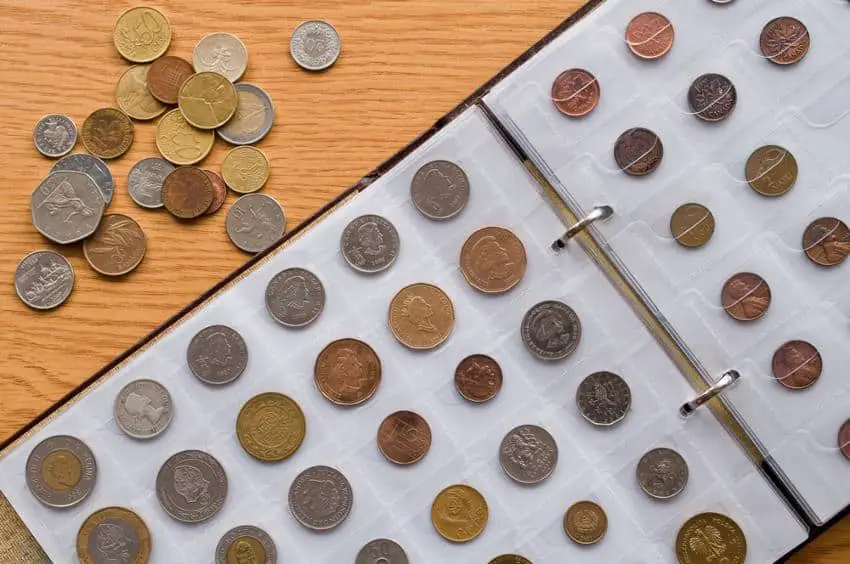
While building your coin collection, one of the biggest questions (aside from what to collect), is the right way to store your coins. Indeed, coin storage is vital to the hobby, otherwise your prized coins could become worthless over time …
… So, how to store your coin collection? In general you should be able to categorize your coins depending on their value, maybe 3 or 4 different degrees of value. Then, pick as many different types of containers (slap, folder, album, box for example) so you will put each category in its suitable container.
The whole point of nurturing a collection is to care for it properly so it will grow and maintain its condition for the many years to come!
This article breakdown the best practices you should follow …
Protecting coins from damage
Metals are subject to corrosion, and coins are no different. Environmental elements that will react with coins and cause damage over time include:
- Air, which contains moisture and often a mixture of chemicals
- Water, including saliva from speaking over unprotected coins
- Chemicals, including those released from paper and plastics
- Sunlight, which contains UV and also produces heat
- Oils, including those from the skin and fingertips
Exposure can cause damage ranging from discoloration to corrosion and pitting. Even small amounts of materials we can’t see with the naked eye, including several listed above, can remain on a coin’s surface and react over time.
The best solution is to keep coins in a sealed environment that is cool, dry, and away from light.
Remember that hard surfaces can also cause marks, including dents and scratches, on coins, so always work with them over a padded surface meant for handling coins.
Types of coin storage
Now that we’ve reviewed the ideal conditions for coin storage, let’s figure out what’s practical. Not every coin can be protected in a professionally sealed, airtight container.
Factors to consider in choosing your method of coin storage include:
- Level of protection
- Cost
- Ease of removing coins
- Ability to view coin surfaces
- Amount of space required
Choosing the right type of coin storage involves balancing all of these different factors. Let’s review the many different options for storing your coins, from least protective and least expensive to the most secure but costly options.
1. Flips
Flips (Check it Here at Amazon) are small, clear plastic envelopes meant for short-term storage of coins. Inside the flip will be a coin along with a small card that has written information.
Flips are often used by coin dealers, because they are cheap and coins can be easily removed for inspection.
Flips are best used for temporary storage of no more than a few weeks. They don’t offer much protection, because they are not sealed and coins can easily fall out.
Avoid flips made from PVC, because the chemicals escaping can harm coins.
2. Folders
Folders (Check it Here at Amazon) are what many collectors will remember as their first storage method when they were young or starting out, and they’re still great for that purpose. Folders are made of thick cardboard that has circular cut-outs for coins to be inserted.
They are like a thin book without the pages, and they can easily sit upright on bookshelves. They are often sold with places marked for individual coins, like a state quarters folder. This way, by filling up the folder, you are completing a set for your collection.
Only one face of the coin will be visible without removing the coin from the folder, and they do not offer much protection from the elements. Make sure to purchase archival quality folders so the cardboard and glues used will not damage your coins.
These are a nice choice for kids.
Fore more check these quality folders!
3. Tubes
Plastic or paper tubes (Check it Here at Amazon) are an economical method of mass storage. Tubes may have a screw-top but will not be completely airtight.
Coins will be stored in stacks and could be damaged from rubbing together, so they are not suitable for storing rare or valuable coins.
Tubes take up less space than other methods, but coins will have to be removed for viewing. Again, make sure they are made of inert plastics that will not leach chemicals that harm your coins.
4. Albums
There’s just something about the feeling you get when flipping through a coin album (Check it Here at Amazon). With all that history at your fingertips, and coins easily viewable from both sides, albums are great for everyday storage so you can peruse your collection and show it to your friends.
Albums are a classic and popular method of coin storage. They are just like a photo album but with sleeves for coins. You can add more pages to your album binder until it’s full. It can be fun to organize and re-organize your coin albums.
Coins inside album sleeves will be set in stapled cardboard with a circular cut-out. These cardboard holders are called 2 x 2s, referring to their size, and they hold the coin in place.
You can write identifying information right on them so it will stay with your coin. Make sure to get a flat stapler to secure the cardboard around your coin as a regular staple can leave jagged edges that damage pages or nearby coins.
Albums offer a bit more protection than folders due to the plastic covering but are not airtight. Always purchase archival quality storage materials from reputable sellers.
5. Coin holders
Coin holders (Check it Here at Amazon) are clear plastic cases designed to fit around a single coin. You purchase them for a specific coin type according to diameter and thickness.
They will keep most circulating air out but are still not airtight. Coins are still easily removed by pulling off the cover. Coins should not fall out, but they can be damaged by sliding around inside the holder.
Coin holders can be stored in boxes or tubes. They offer a good amount of protection for their price, but the best is yet to come.
6. Slabs
Your rare and high-value coins belong in a Slab (Check it Here Amazon) for optimal protection. Slabs are plastic cases that have been sonically sealed and are therefore airtight. Inside the hard-shell case, the coin sits inside a softer plastic to give it a nice cozy resting spot that keeps it from vibrating or shifting to prevent damage.
Encapsulating, the term for getting a coin placed in a slab, is done by professionals. Your coin will be certified, graded, and sealed inside the slab before being returned to you. It can be viewed through the clear sides of the slab but should not be removed.
This is the most expensive and most protective method of coin storage. Collectors who buy an encapsulated coin can be confident in their purchase due to the certification and superb storage.
7. Coin boxes and cases
Coins stored individually in flips, tubes, holders, or slabs will typically be placed inside a box or case for storage (Check it Here at Amazon). Again, there are a range of options. The most basic option starts with cardboard storage boxes.
From there, there are wooden boxes and aluminum-sided cases, which often have padded inserts for keeping individual coins secure in their holders. These may also be called presentation cases.
Wooden storage boxes with drawers can be a beautiful option for home storage, whereas smaller briefcase-style cases are better suited for taking your coins on the road.
Where to store coins
Now that you’ve got your coins inside a container, where should you put them? Let’s review the options.
No matter which you choose, strongly consider including a desiccant packet (which will need to be replaced over time) or electronic dehumidifier inside your coin box, case, or safe to reduce moisture levels.
1. Home Sweet Home
By far, the most common location for storing coin collections is home. It makes sense so you can have your coins at hand to admire, display, or even sell when the time is right.
Check with your renter’s or homeowner’s insurance policy to make sure your coin collection will be covered or to add it (I wouldn’t do so honestly!). You can also store valuable coins inside a safe in your home.
Remember, by placing coins on display, you may be exposing them to elements such as heat and sunlight or potentially inviting theft. Cool and dry are still the best qualities for coin storage.
2. Storage unit
Though a storage unit can seem convenient, they come with several drawbacks. You won’t be using up precious space in your home, but you won’t have easy access to your coins and there is still risk of theft.
You’ll only want to store your coins in temperature-controlled storage units, and even then, be mindful that the management company may sometimes fail to keep the conditions within optimum range.
Storage units can be pricey, and if you don’t pay your storage unit bill, your belongings can be sold off at auction.
3. Safe deposit box
Safe deposit boxes at your bank are a great option for storing a few precious coins. They are secure and locked away from theft. You won’t be able to admire your coins readily, but you can rest easy knowing they are safe.
You’ll pay a small fee for use of a safe deposit box. Space will be at a premium as they are often very small.
Final Thoughts: Storing your coins safely
Hopefully you now have a better idea of the many options for storing the coins in your collection. Being knowledgeable in what can damage coins as well as optimal storage conditions can help you protect your investment.
With the right coin storage choices, you and future generations will be enjoying your coins many years from now.
Finally, if you want to get started in this hobby the right way, then have a look at this beginner guide! You will learn a Ton:
